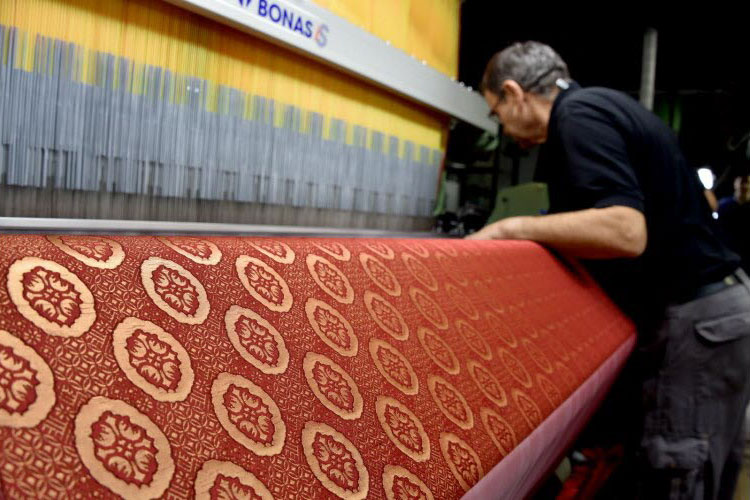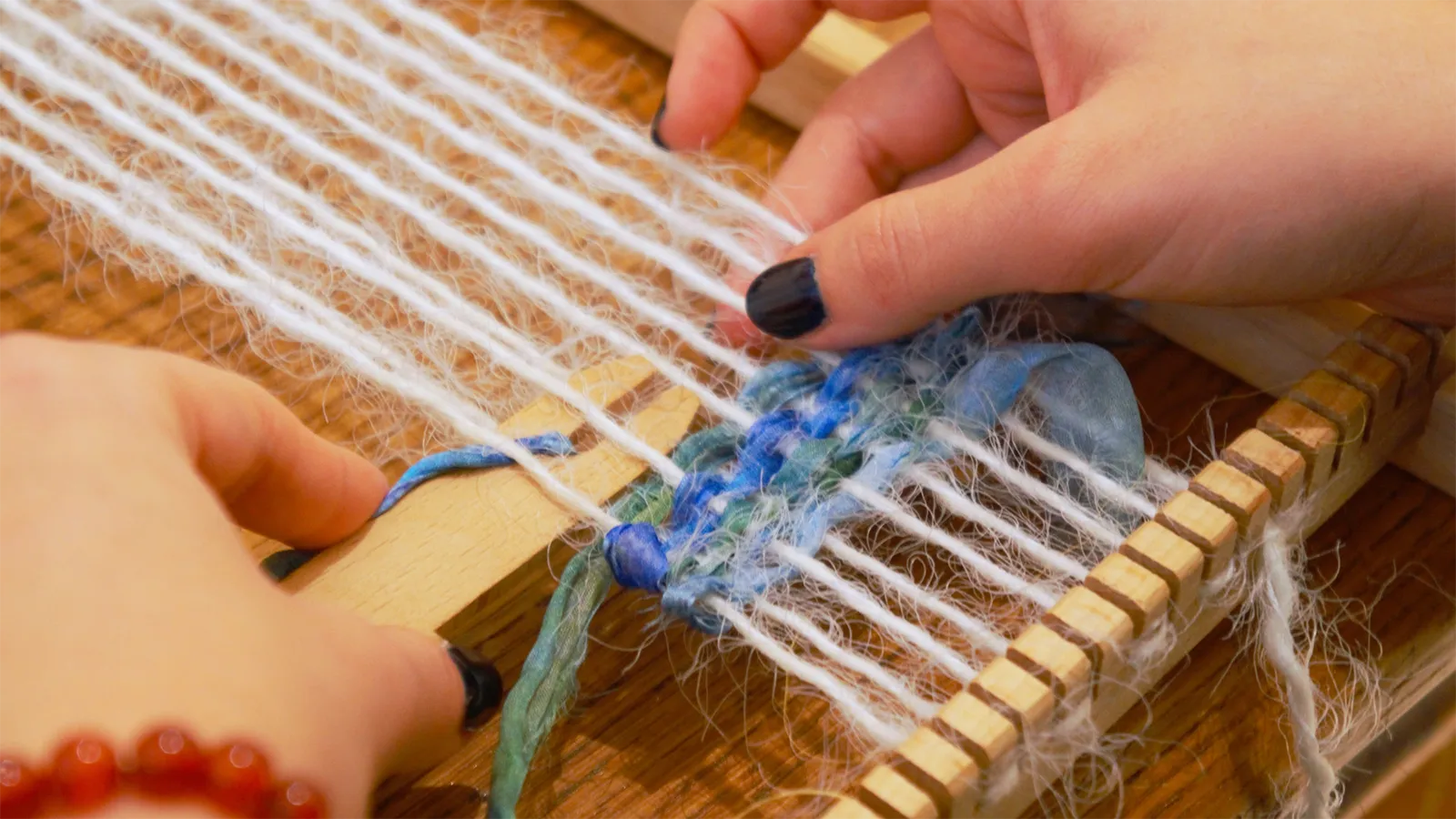
The history and techniques ofweaving in France
Weaving is a process in which two separate sets of threads are woven at right angles to each other to form a fabric. The vertical threads are called the warp and the horizontal threads are the weft. The way in which the warp and weft threads criss-cross is called the weave.
The majority of products woven today are made in one of the three most common weaves: plain weave, satin, or twill.
The woven fabric can be plain (one colour all over), or can be woven with decorative or artistic patterns. The variety of weaves and the possibility of mixing silk yarn with other fibres (e.g. wool or cotton) means that there is no limit to the fabrics that can be created, giving an infinite number of textures, flows, falls, colours and patterns.
In 18th-century Europe, weavers worked on increasingly complex hand looms. In France, the inventions of Basile Bouchon, Jean-Baptiste Falcon and Jacques Vaucanson were important milestones in the improvement of looms. Then, in 1801, weaving underwent a decisive technical revolution with the invention of the Jacquard loom by Joseph Marie Jacquard in Lyon..
The Jacquard loom is made up of two parts: the draw loom, which is used to produce decorated (figured) fabrics, and the Jacquard mechanism, which sits on top of the draw loom.
The Jacquard mechanism was not so much an invention as a skilful combination of three techniques:
- Basile Bouchon’s needles, an adaptation of the clock mechanism to weaving, used to read a perforated tape (1725);
- Jean-Baptiste Falcon’s system of perforated pasteboard cards and an infinite chain of cards, which enabled non-stop control of the loom (1728)
- Vaucanson’s loom, which was automated by a hydraulic system and operated by analogue cylinders (1748).
The result was a semi-automatic loom with a square cylinder that controls all the threads – via 600 to 800 hooks – and selects them using a programme written on punched cards, to create varied and complicated patterns.
Its main advantage was that it could be operated by a single person. After a few improvements by the mechanic Jean-Antoine Breton, the Jacquard loom enabled faster and much cheaper production than on previous looms.
Despite initial reluctance on the part of the workers, who saw it as a threat to their jobs, people soon realised the benefits of the Jacquard loom: it made work easier and improved the quality of production.
In 1834, there were 2,885 looms operating on the slopes of the Croix-Rousse in Lyon. By the end of the 19th century, there were almost 20,000 ! The Croix-Rousse silk manufacturers began to specialise in fabrics with complex patterns, including brocade, damask and panne velvet.

The technique
- 1950
The Jacquard mechanism remains the key element in modern, mechanised and computerised looms. In the 1950s, Joseph Brochier modified his looms to weave fibreglass for the manufacture of flame-retardant fabrics.
- 1970
In the 1970s, Jean Brochier developed 3D weaving to weave the nosecone for Concorde and then the nozzles for aircraft jet engines, as well as rocket engines and launchers. Other looms were modified to weave carbon fibre, which, once woven, was coated to create composite materials.
- 2000
In 2000, Cédric Brochier adapted the looms for optical fibre weaving.
The manufacture of intelligent luminous fabrics is now used in a wide range of sectors, including health, the automotive industry, transport and architecture.

Welcome to the Musée Soieries Brochier

Practical information
The museum is open every day 10 am - 1 pm & 2 pm - 7 pm. On Sunday 10 am - 1 pm & 2 pm - 6 pm.
Adults €8 / 14-25 years €6 / Free for under-14s
The Lyon City Card can be used to visit the museum
Contact details
Musée Soieries Brochier
Grand Hôtel-Dieu
18 quai Jules Courmont - Lyon 2ème
Map
Public transportation:
Metro line A and Line D | Bellecour station
Bus 27, A32, A71 | Pont Guillotière RD station
Bus C9, C12, C20, C20E, 40, 51 | Bellecour Le Viste station
Plan a journey
TAKE PART IN A WORKSHOP AT THE MUSEUM

Weaving workshop
Duration: 2h
Booking required
1 to 3 people
Adults €80 / children €30
Venue: Musée Soieries Brochier
Includes free admission to the Musée Soieries Brochier!
Find out more about the Weaving workshop
Weaving is at the heart of our expertise, as the Jacquard loom in the middle of our museum demonstrates.
After a presentation of weaving on this hundred-year-old loom, we’ll introduce you to the secrets of weaving silk tweed (Chanel’s signature fabric) using small wooden looms.
After the session, be sure to visit the museum, where you will discover the story of four generations of the Brochier family through the history of silk in Lyon – a history that now includes you!

Silk embroidery workshop
Duration: 3h
Booking required
2 to 5 people
90 € / per person
Venue: Musée Soieries Brochier
Includes free admission to the Musée Soieries Brochier!
Find out more about the Silk embroidery workshop
The art of embroidery has been used to embellish exceptional fabrics for thousands of years. You will be introduced to contemporary embroidery by embroidering from the designs of Raoul Dufy, one of the greatest textile designers of the 20th century. He created designs from 1912 to 1928 for the prestigious Bianchini Férier company, of which he was also artistic director. After the session, when you’ve finished your silk embroidery, be sure to visit the museum, where you can discover the history of the close links, spanning four generations, between the Brochier family and the great artists and couturiers of the last century. Especially now that you’re part of the story, too!
BOOK YOUR GUIDED TOUR

The museum entrance ticket
Duration : about 1hAdults 8 € / 14-25 years 6 €
Location : Musée Soieries BrochierFind out more about our the museum guided tour
In the heart of the city of Lyon, within the prestigious walls of the Grand Hotel Dieu, the new Musée des Soieries Brochier is now open.
We invite you to explore 130 years in the history of a prominent Lyon family that set out in the silk industry in 1890: 4 generations, 9 Brochiers and hundreds of thousands of metres of silk, woven and printed for the greatest names in haute couture and the arts have been involved over a period of more than a hundred years.
Come and admire dresses by Hubert de Givenchy, Christian Lacroix, Valentino, Yves Saint Laurent and Nicolas Fafiotte, created with fabrics from the Brochier silk house.
And discover textile designs by such 20th century masters as Miró, Calder and Cocteau that reflect the Brochier family’s close involvement with artists.
Discover also how a thirst for innovation made it possible to adapt the Jacquard loom for the production of technical fabrics for Concord nose cones, rainforest canopy rafts, and the Venus balloon probes. And learn how silk thread is now woven with optical fibres to produce the fabrics of the future.
The Musée Soieries Brochier is the ideal starting point for a visit to Lyon that combines heritage with history. The museum shop is open to the public and offers a wide range of hand-painted, 100% silk and velvet squares made in Lyon in the silk weaving mills and printing workshops of Brochier Soieries.
The museum is part of our Silk Trail, which offers visitors the opportunity to visit our silk printing workshop on the Place des Terreaux and then to inspect a mini silkworm farm on the Rue du Boeuf in the Mediaeval and Renaissance quarter of the town (St Jean).

The workshop guided tour
Duration : 1h
Group fares
Subject to reservation
Location : Brochier Soieries workshop
Find out more about the workshop guided tour
The Brochier Soieries workshop invites you to discover its traditional skills: frame printing “à la lyonnaise”, hand-painted silk velvet panne and block printing.
Our silk printing workshop is the last workshop in France still in operation to perpetuate by hand this traditional process, invented in Lyon in 1920 and long used by manufacturers to produce prints on fabric. With 3,000 frames, some dating back to 1950, we produce a wide variety of graphics, combining tradition and modernity.
During your visit, our printers will share the secrets of Lyon’s expertise, so highly prized by the great couturiers of the 20th century.
You’ll discover the techniques of frame printing “à la lyonnaise” and block printing: qualities of silk fabrics, installation of silk rolls on long printing tables, cooking of colors, smoothness of colored pastes, printing, drying and fixing. Upstairs, you’ll be invited to a demonstration of hand-painting on velvet panne, a renowned specialty of Lyon!
